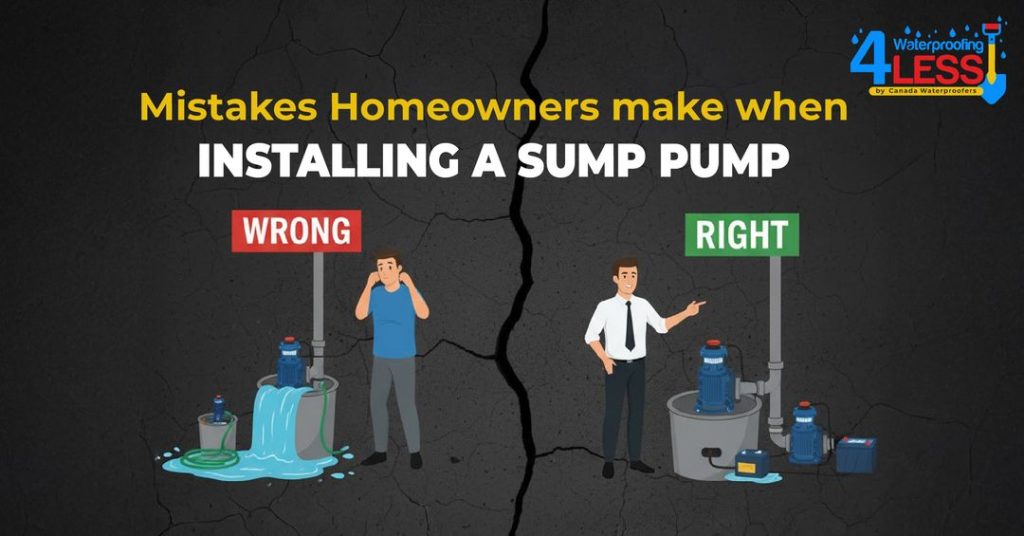
Mistakes Homeowners Make When Installing A Sump Pump
Think waterproofing is only needed when you see water? Learn why this belief can lead to costly damage. Discover how proactive measures protect your GTA home from hidden moisture issues.
A sump pump can save your basement from turning into a damp mess. But here’s the twist – most people mess up during installation. And when that happens, the pump fails at the worst possible time. Leaks. Flooding. Costly repairs. All because of a few avoidable mistakes.
Let’s walk through them one by one.
A lot of trouble actually starts before the installation itself. Many homeowners grab the cheapest or smallest pump they find, thinking, “It’s just a pump, right?” Nope.
If the pump isn’t powerful enough, it won’t handle heavy water flow or deep pits. It wears out fast and gives up right when the water rises.
Tip: Match the pump to your basement size and water level. Submersible sump pumps work best for deeper pits with more water. Pedestal pumps are fine for smaller setups but not built for big volumes.
Here’s one people don’t think about — pit size. If your pit is too small, the pump keeps switching on and off constantly. That’s called short cycling, and it slowly kills the motor.
A good pit is usually around 18 inches wide and 24 inches deep. Big enough to hold water, small enough to work efficiently.
This tiny part is a hero. The check valve stops water from flowing back into the pit once the pump turns off. Some people forget it. Some install it upside down. Either way, water returns, the pump keeps running, and you’re wasting power.
You can have the best pump in the world, but if the discharge pipe is wrong, water’s coming right back in. Or worse — freezing inside the pipe in winter.
Improper installation of a sump pump discharge pipe can lead to serious issues. If the pipe ends too close to the house, water may seep back into the basement. To prevent this, extend it at least 10–20 feet away from the foundation. A lack of slope can cause water to stagnate and freeze, especially in colder climates.
Using the wrong pipe size can strain the pump, leading to failure. Always use the manufacturer’s recommended size. Installing a check valve prevents water from flowing back into the sump pit. And don’t forget regular maintenance — inspect for clogs and ensure proper slope.
For reliable installation and drainage solutions, check out our basement waterproofing services.
Imagine a storm, the power goes out, and… the pump stops. This happens more often than you’d think. Relying on electricity alone is risky.
Simple fix: Add a battery backup pump or a water-powered system. If one fails, the other steps in. It’s like insurance for your basement.
Some folks just drop the pump into the pit like a rock. Others prop it on uneven blocks. The result? A tilted pump that vibrates, sucks in air, or gets jammed.
Always place it on a flat, solid base. Think less “whatever fits,” more “stable and level.”
This one’s sneaky. An uncovered pit lets moisture escape, smells spread, and debris fall in. Over time, that gunk clogs the pump.
A proper cover keeps the pit sealed, the basement cleaner, and the pump happier.
People install it and forget it — until the basement floods. But a sump pump needs a little care.
Quick checklist:
Ten minutes, tops. But it can save you thousands. Regular sump pump inspections in Mississauga keep everything in shape.
This is classic. Using low-quality pipes and fittings seems like a small compromise at first. Later, when they crack or leak, it’s a big headache.
Stick to proper PVC pipes and strong connectors. Seal everything well. It’s not the place to cut corners.
Even if you installed it yourself, getting a professional inspection once is smart.
A plumber can spot small things you’d easily miss — float position, electrical issues, slope errors, backup setup. One check gives peace of mind.
Some basements get hit hard during storms. Relying on one pump can be a gamble. If it fails, water doesn’t wait politely.
Installing a second sump pump system gives you backup during heavy rain.
Every area has its own building codes. Discharge placement, connections, backflow rules — all that stuff matters. Skipping this can land you with fines or forced changes.
Strange noise? Constant running? Slow drainage? Many people ignore these signs, thinking they’ll deal with it later. That “later” often turns into a flooded floor.
Address issues as soon as you spot them. Water problems don’t wait.
Setting up a sump pump isn’t complicated, but it demands care. Most mistakes — wrong pump size, missing check valve, sloppy discharge line, no backup — are completely avoidable.
Take your time, use proper materials, do quick checks, and don’t delay fixes. If needed, call a pro once. A little attention now protects your basement, foundation, and wallet later.




Think waterproofing is only needed when you see water? Learn why this belief can lead to costly damage. Discover how proactive measures protect your GTA home from hidden moisture issues.